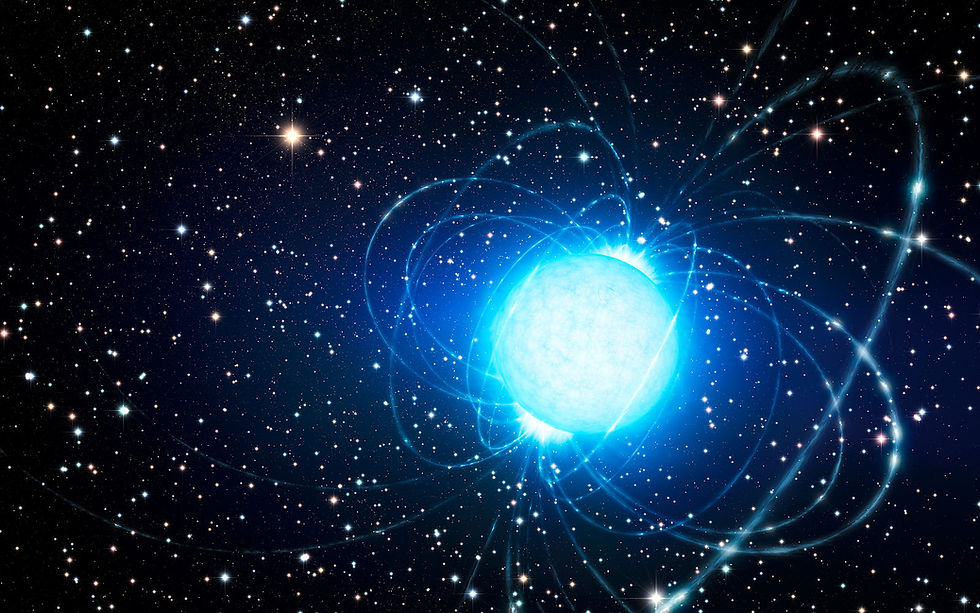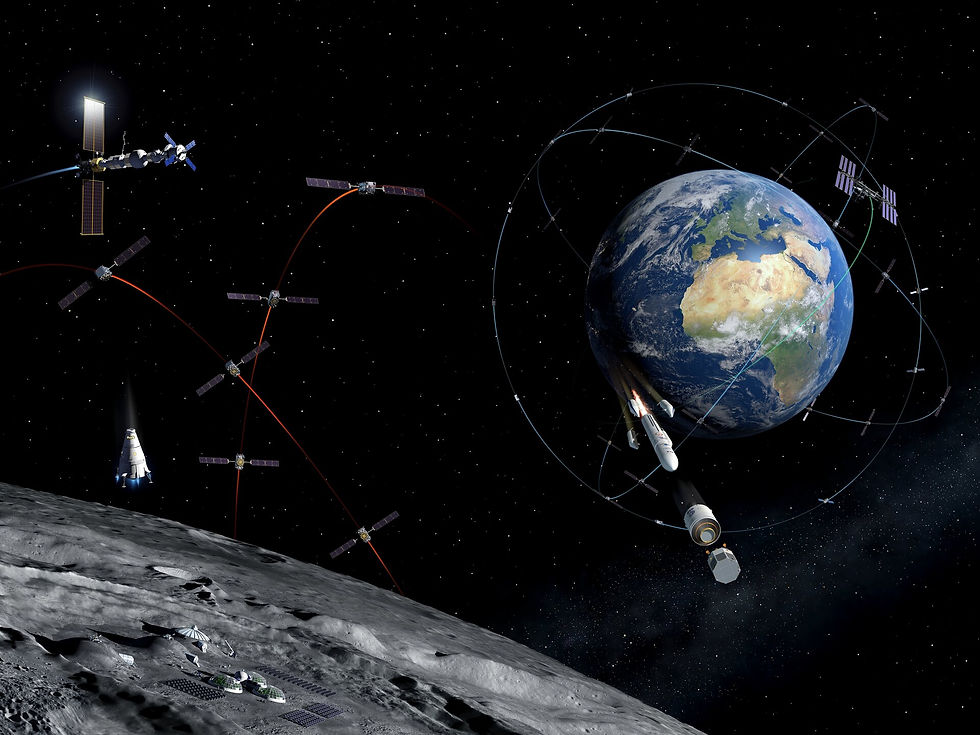The World’s Biggest Telescope
- Webmaster
- Feb 6, 2021
- 5 min read
Updated: Mar 20, 2021
What is the Square Kilometre Array?
Unlike a normal telescope made of one detector, the Square Kilometre Array is a collection of radio telescopes and antennas which have a square kilometre of collecting area (or nearly 220 Lovell Telescopes! [1]), located in deserts two countries (Australia and South Africa), which, you’ll notice, don’t have a land border, but combine the data they produce from two different arrays [2], made from 197 mid-frequency (350 MHz to 15.3 GHz) dishes in South Africa and ~131,000 low-frequency (50 MHz to 350 MHz ) antennas in Australia [6]. It even outdoes the famous Hubble Space Telescope, with 50 times the image resolution [2].
Also, this global collaboration, with 16 countries taking part as well as 8 African partner countries [3], held its first meeting on the 4th February, approving and actioning the plans to construct this colossal project, costing a total of £1.8bn to build and operate [4].

Low Frequency = Down Right, ASKAP = Back right, Mid-frequency = Up Left, MeerKAT = Back Left. Credit: SKA Organisation, CC BY 3.0
The Plan of Action
The Square Kilometre Array was conceived all the way back in September 1993 [5], leading, after many years of planning, to 4 precursor facilities (telescopes on the sites in South Africa and Australia to help the design of the Square Kilometre Array to be built there), and 17 pathfinder telescopes (trialing technology to be used on the Australian and South African sites in the future) including e-MERLIN [8] (An array of 7 UK based radio telescopes, including the 3 at Jodrell Bank [7]).
Then, in 2020, the construction of the first phase started, to be ready to be in full operation by 2022. Stage 2, a stage to bring much higher sensitivity to the array [6], will then be constructed between 2023 to 2030 [9], spreading out across the African continent to fulfil this high sensitivity goal [3].

A MeerKAT Radio Telescope. Credit: Morganoshell, CC BY-SA 4.0
Challenges
Such an ambitious project in such extreme environments holds with it a lot of challenges. First of all, the amount of data produced will be enormous: ~700 petabytes [10], or the same as over a million 500GB laptops [11], with just the Australian array transmitting enough data to fill 27 million laptops everyday, or 5 times 2015’s total internet traffic [13] (although I’m not sure about 2020s!). Then, to transmit this data, there will be as much optical fibre as to wrap two times around the entire Earth and the data itself will move 100,000 times faster than the 2022 projected broadband speed [12]!
However, to transmit all this data, a lot of power is needed, but where is it all going to come from when you’re in the middle of a desert? In Australia, they found the answer in the abundance of solar energy, using a solar hybrid power station producing power to be stored in a 2.5MWh lithium-ion battery [15] (over 595,000 times that of an AA battery [14]).
Also, being in a desert has other, more obvious, challenges, like deploying thousands of antennas and radio dishes over a remote plane with no roads and harsh arid conditions, demanding stable and accurate pointing, whilst the installation is quick and easy to carry out, with people and equipment kept to a minimum.
Scale is also, aptly, a large issue, needing low costs per dish for mass manufacture, yet high sensitivity [16]. The scale, in terms of it being an international effort, can also be seen, with many engineers from across the globe working to help solve problems and build different parts of the telescope. The components need therefore to be portable enough to be moved from many different parts of the globe, and the engineers adaptable enough to work with people in very different time zones [10].

South Africa SKA central core (artwork). Credit: SPDO/TDP/DRAO/Swinburne Astronomy Productions, CC BY 3.0
Why do it?
The array will help advance science at a much faster rate than previously because of its high sensitivity. There are 8 key topics which this is being built to play a key role in:
The formation of the first structures at the beginning of the Universe and the change from neutral to ionised states of matter (no charge to charged).
Finding pulsars (neutron stars with radio waves coming from their poles, observed on Earth as a regular “blip” when using radio telescopes) for precision time measurements for investigating the characteristics of space and time.
Investigating the formation and evolution of galaxies.
Probing the foundations of our understanding of the Universe, including of dark energy (an illusive energy which is accelerating the expansion of the Universe).
Looking at the origin, structure and evolution of magnetic fields, key to much of what goes on in Space.
Delving into how life originates and evolves into intelligent technologically minded beings, like us.
Conducting high resolution surveys of galaxies and galaxy clusters to advance our understanding of them.
Discovering transient (short lived, even less than a nanosecond long) phenomena because of its fast rate of surveying the sky, looking for everything from Gamma Ray Bursts (produced by everything from supernovae to neutron stars merging, with the afterglow being detectable, not in the higher energy gamma ray range) to supernovae (explosions of high mass stars as they change from a red supergiant to a black hole or neutron star) and Fast Radio Bursts (with the exact origin still unknown, made up of radio pulses less than a millisecond long) [17].
Magnetar (neutron star with magnetic field) in star cluster Westerlund 1 (artwork).
Credit: SO/L. Calçada, CC BY 4.0
This truly revolutionary international project will pave the way for new theories and new understandings about our place in the Universe, but also create new questions which will hopefully also be uncovered by this adaptable and state-of-the-art array.
by George Abraham, ADAS member.
Click here for the previous news article
Click here for the next news article
Click here to listen to pulsars in action
Click here to look at how you can get involved in the project
References
"The History of Jodrell Bank". Jodrell Bank Centre for Astrophysics. Archived from the original on 6th February 2021.
"SKA Project", Square Kilometre Array. Archived from the original on 6th February 2021.
"Participating Countries". Square Kilometre Array. Archived from the original on 6th February 2021.
"Square Kilometre Array: 'Lift-off' for world's biggest telescope". BBC News. Archived from the original on 6th February 2021.
"The History of the SKA Project". Square Kilometre Array. Archived from the original on 6th February 2021.
"Technical Information The Telescopes". Square Kilometre Array. Archived from the original on 6th February 2021.
"eMERLIN". eMERLIN. Archived from the original on 6th February 2021.
"Precursors and Pathfinders". Square Kilometre Array. Archived from the original on 6th February 2021.
"Square Kilometre Array Prospectus". Square Kilometre Array. Archived from the original on 6th February 2021.
"SKAO - a new observatory to explore the Universe". YouTube. Archived from the original on 6th February 2021.
"Amazing Facts". Square Kilometre Array. Archived from the original on 6th February 2021.
"Technical Information The Operational Model". Square Kilometre Array. Archived from the original on 6th February 2021.
"The Square Kilometre Array". CSIRO. Archived from the original on 6th February 2021.
"Energizer Watt-Hour Battery Specs". Sciencing. Archived from the original on 6th February 2021.
"Our Murchison Radio Astronomy Observatory". YouTube. Archived from the original on 6th February 2021.
"SKA Dishes". Square Kilometre Array. Archived from the original on 6th February 2021.
"The Square Kilometre Array (SKA)". Jodrell Bank Centre for Astrophysics. Archived from the original on 6th February 2021.










Comments